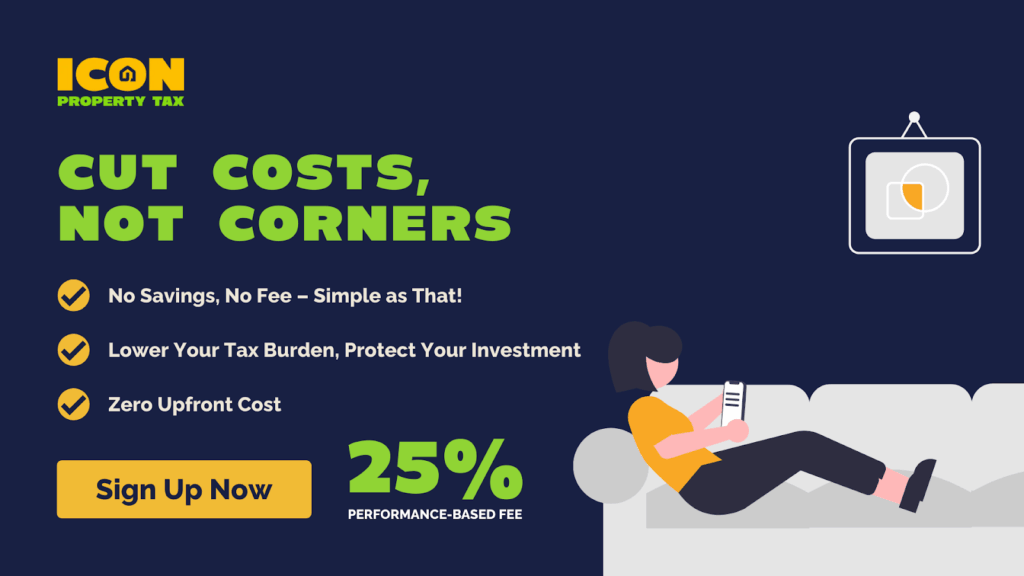How Property Taxes Support Texas Communities And Services
September 4, 2025
Key Takeaways:
- Community Services Funded By Property Taxes: Property taxes in Texas are essential for funding local community needs, including public schools, libraries, parks, and community centers, directly impacting educational resources, public amenities, and social services.
- Variations In County Tax Rates: Property tax rates across Texas counties reflect local priorities, with differences driven by school district requirements, public spending needs, and property value fluctuations.
- Transparency Through Truth-In-Taxation Laws: Truth-in-Taxation laws ensure transparency in how property tax rates are set and allow property owners to understand and engage in the process, empowering them to advocate for fair assessments and manage their tax liabilities effectively.
Icon has delivered over $100 million in property tax savings, combining more than 30 years of expertise with a proven 90 percent success rate. Last year alone, 82 percent of our clients saw reductions. Our performance-based model means no upfront fees, only results. With local knowledge, advanced technology, and a relentless focus on fairness, Icon stands out as a trusted advocate for property owners seeking relief from inflated assessments.
Many Texans ask: What do property taxes pay for? These taxes provide the foundation for schools, emergency services, roads, libraries, and countless community programs. Counties, cities, and districts depend on them to keep essential services running smoothly. Rising values and changing rates can be burdensome, but property owners who understand how their money is used gain the knowledge to manage assessments better, make informed decisions, and protect their financial interests.
In this blog, we’ll break down what property taxes pay for in Texas, how local governments allocate these funds, and why understanding their role can help property owners make smarter financial decisions.

Why Property Taxes Vary Across Texas Counties
Texas covers many communities, and each county has its own approach to setting property tax rates. To understand these differences, it helps to look at the drivers that shape how rates are calculated and applied.
Local Priorities And Community Needs
Every county sets property tax rates that reflect its unique circumstances. Urban counties like Harris or Dallas often levy higher infrastructure, schools, and public safety taxes. In contrast, rural counties may adopt different approaches to balance smaller budgets with essential services.
The Role Of School District Funding
School districts heavily influence local property taxes because Texas relies on them to fund education. Counties with rapidly growing populations or newly built schools typically require more revenue, directly affecting property owners’ tax bills.
Appraisals As The Basis For Tax Bills
County appraisal districts reassess property values annually, forming the foundation for tax calculations. In hot markets like Austin or Houston, rising home values increase bills even if rates remain unchanged, while slower markets may experience less dramatic changes.
Government Spending And Economic Shifts
Local spending decisions also play a significant role. Like voter-approved bonds, funding for road repairs, emergency services, and public health programs impacts tax rates. Economic shifts, such as new or departing employers, can reshape the tax base and service requirements.
Transparency And Property Owner Advocacy
Texas transparency laws require counties to disclose how property taxes are calculated and spent. Even with these disclosures, property owners often find the system complex. Understanding these local dynamics is critical for advocating accurate appraisals and protecting against inflated tax bills.
Rural Versus Urban Services: Comparing Tax-Funded Benefits
Property taxes fund communities across Texas, but how dollars are allocated differs between rural and urban areas. Examining the services supported in each setting is essential to see how these differences impact your bill.
Core Services In Rural Communities
In rural counties, property taxes often prioritize essentials. Schools rely on this revenue to support smaller classes and operations across large geographic areas. Volunteer fire departments, sheriff’s offices, and rural health clinics depend on tax funding for reliable emergency response and basic healthcare access. Road maintenance and water districts also lean on property taxes to sustain infrastructure in less densely populated regions.
Broader Public Services In Urban Areas
Urban taxpayers contribute to a vast network of services. Property tax dollars fund large police and fire departments, public libraries, and city parks. Infrastructure needs are more complex, covering highways, bridges, water treatment, and transit systems. Urban school districts use these funds to serve thousands of students, maintain multiple campuses, and support advanced programs.
Differences In Priorities And Outcomes
Rural property taxes are directed toward keeping essential services functional with limited resources, while urban taxes are spread across basic and additional municipal services. This might mean new libraries, expanded bus routes, or upgraded city emergency systems. In contrast, rural areas may invest in gravel roads, updated schoolhouses, or new equipment for local fire departments.
Why Understanding Allocation Matters For Owners
Regardless of where you live, property taxes remain a critical funding source. For property owners considering an appeal, understanding how funds are allocated provides valuable context for assessing fairness, accuracy, and the actual burden carried by local governments.
Libraries, Parks, And Community Centers: Cultural Benefits Funded By Taxes
Many people think of schools and roads when exploring what property taxes pay for. Yet property taxes also sustain the cultural and social infrastructure that shapes daily life across Texas communities.
How Property Taxes Support Public Libraries
Libraries in Texas have evolved into vital community hubs. Property tax funding keeps branches open, stocked, and digitally connected. These spaces provide free internet access, job resources, maker labs, early literacy programs, and safe gathering spaces. Tax-supported libraries help children discover learning, assist adults in career changes, and offer inclusive access to information for all residents.
Parks And Green Spaces As Essential Assets
Property taxes also fund the creation and upkeep of parks, trails, and playgrounds. Clean, safe, accessible outdoor spaces encourage family recreation, community engagement, and healthier lifestyles. In Texas, where summer heat can be extreme, shaded green spaces are more than amenities; they are essential resources for public well-being and quality of life.
The Role Of Community Centers In Local Life
Community centers funded by property taxes provide flexible educational, wellness, and civic engagement spaces. These facilities host tutoring programs, health clinics, voter registration, and cultural events. During emergencies, many also serve as shelters. At other times, they strengthen neighborhoods by offering residents meeting rooms and gathering spaces.
Why Cultural Investments Matter
The benefits of property taxes extend beyond infrastructure and safety; they sustain community life. From a child’s first library book to a neighborhood festival or a family picnic in the park, these tax-supported services deliver value directly to residents. Every dollar invested helps build stronger, more connected communities across Texas.

Special Purpose Districts: MUDs, PUDs, And Their Impact On Your Bill
Many Texas property owners notice abbreviations like MUD, PUD, or SUD on their tax statements. These represent special-purpose districts, local entities created to fund infrastructure or services for defined areas. Understanding their origin, purpose, and role in the community of financing needs helps you see how they affect your bill.
The Origin And Purpose Behind Special Districts
Texas’s rapid population growth often outpaces city budgets for roads, drainage, and water systems. Developers and property owners establish Municipal Utility Districts (MUDs) or Public Utility Districts (PUDs) to fill the gap. These districts levy property taxes to fund essentials such as water, sewerage, drainage, and parks, providing services tailored to new or growing neighborhoods.
Services Provided By MUDs And PUDs
MUDs are typical in areas outside city limits, financing water and wastewater facilities that make development possible. PUDs offer a broader scope, managing utilities while funding parks, open spaces, and community centers. Residents benefit from these services directly, but are funded separately by city or county governments.
How District Taxes Appear On Your Bill
If your property lies within a special district, part of your property tax goes directly to it. Each district sets its own rate, which can fluctuate depending on capital projects, bond repayments, or ongoing maintenance. For many owners, district taxes rank just behind school taxes as one of the largest line items on their annual statements.
Why Oversight Of District Taxes Matters
Rates in special-purpose districts can rise or fall year to year. New projects or repairs may increase obligations, while debt repayment can lower rates over time. Attending public meetings and reviewing district budgets helps property owners hold these entities accountable and advocate for fair, accurate taxation.
What Property Taxes Pay For In Special Districts
Special districts provide some of the clearest examples of what property taxes pay for: water systems, parks, garbage collection, and community amenities visible in daily life. These locally funded projects highlight how property tax dollars are put to work, often shaping neighborhoods block by block.
Appeal Deadlines: Key Dates To Protect Your Right To Fair Taxes
Property tax appeal deadlines in Texas are tightly enforced, and missing them can mean paying more than necessary for another year. Understanding these timelines helps property owners take timely action and safeguard their right to fair taxation. Staying informed is the first step toward controlling your tax liability.
- The Standard Protest Deadline: Most Texas property owners must file protests by May 15 or within 30 days of receiving their appraisal notice, whichever is later. These deadlines are tied to local appraisal district calendars, so confirming specific dates for your county each year is essential rather than relying on assumptions.
- Impact Of Missing A Deadline: Failing to protest on time locks in your current year’s valuation, even if it is inflated or based on inaccurate market data. This can increase your annual tax bill and create a higher starting point for future appraisals, compounding the financial impact on homeowners and commercial investors.
- Special Deadlines For Supplemental Notices: Supplemental or corrected notices, often issued for clerical errors or late reappraisals, trigger their own 30-day protest window. Because they arrive outside the usual protest season, many owners miss them unless they carefully track incoming mail and check appraisal district announcements regularly.
- Deadlines For Further Appeals: If you disagree with the Appraisal Review Board’s decision, strict timelines apply for escalating your case to district court, arbitration, or binding settlement. Each option comes with unique filing requirements and timeframes, and missing them permanently ends your ability to continue challenging the valuation for that year.
- The Importance Of Proactive Planning: Tracking key dates, monitoring your assessed value online, and marking calendars with district deadlines ensures you don’t miss opportunities to contest unfair valuations. Proactive planning also reduces last-minute stress, giving you time to collect evidence and prepare a stronger, more persuasive case before submitting your protest.
Every property owner, whether managing a single home or multiple commercial properties, faces real financial consequences if deadlines are ignored. By acting within the set protest windows, you strengthen your position to achieve fair property tax outcomes, protect your budget, and avoid unnecessary costs that could last for years.

Final Thoughts
Property taxes are foundational in shaping Texas communities, funding everything from public schools to emergency response. Yet, that impact doesn’t mean you should passively accept your appraisal. Every property owner deserves an advocate who fights for a fair assessment, one reflecting the actual value of their property and not a dollar more.
With Icon, fighting for savings on your property tax bill is straightforward and data-driven. Transparency, local knowledge, and effective negotiation are at the core of our operations. The dollars you don’t overpay can stay in your pocket or be reinvested into your home or business, strengthening your finances and community. You never pay up front, and we only charge a fee if you save money.
Don’t let your tax bill go unchallenged. Search your property address today and let Icon stand up for your right to fair property taxes.
Read also:
- Texas Cost Of Living Explained: Housing, Utilities, Taxes & More
- Austin Living Costs: Housing, Income, And Daily Expenses
- Can You Avoid Property Taxes? States With No Or Low Rates
Frequently Asked Questions About What Do Property Taxes Pay For
What are property taxes?
Property taxes are mandatory payments based on assessed property value. In Texas, they fund schools, infrastructure, and public services, making it essential for owners to monitor appraisals and avoid overpaying.
How are property taxes calculated in Texas?
Property taxes in Texas are calculated by multiplying the appraised property value by the tax rates set by local authorities. Annual bills vary depending on county, city, school, and special district budget needs.
Who determines the property tax rate in Texas?
Local governing bodies such as city councils, county commissioners, and school boards set tax rates annually. These rates are based on appraisal values and budget requirements for essential community services.
What services do property taxes fund in Texas?
Property taxes fund public schools, parks, roads, libraries, fire protection, police, and emergency medical services. These contributions directly support community infrastructure, safety, and everyday services across cities, counties, and school districts.
How do property taxes support public schools in Texas?
School districts rely heavily on property tax revenue. These funds cover teacher salaries, facilities, transportation, and classroom materials, providing consistent educational support and allowing districts to operate effectively.
What percentage of property taxes goes to local governments?
On average, more than 95 percent of Texas property tax revenue goes directly to local governments, including counties, cities, schools, and special-purpose districts like hospitals, colleges, and water authorities.

